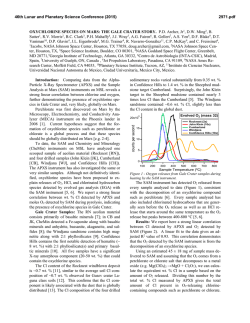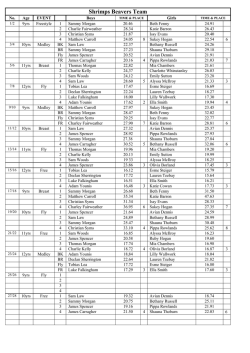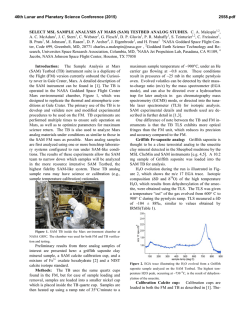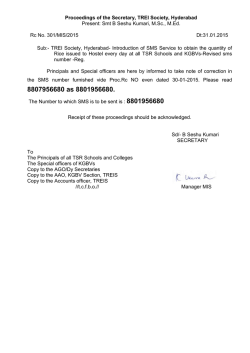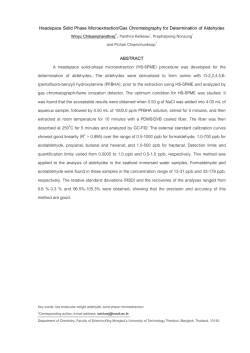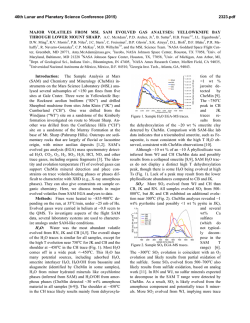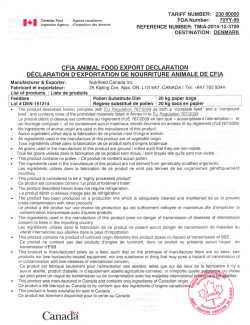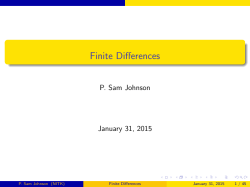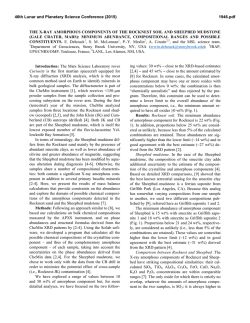
FIRST IN SITU WET CHEMISTRY EXPERIMENT ON MARS USING
46th Lunar and Planetary Science Conference (2015) 2934.pdf FIRST IN SITU WET CHEMISTRY EXPERIMENT ON MARS USING THE SAM INSTRUMENT: MTBSTFA DERIVATIZATION ON A MARTIAN MUDSTONE. C. Freissinet1,2, D. P. Glavin1, A. Buch3, C. Szopa4, S. Kashyap5, H. B. Franz1, J. L. Eigenbrode1, W. B. Brinckerhoff1, R. Navarro-González6, S. Teinturier1, C. A. Malespin1, B. D. Prats1, P. R. Mahaffy1 and the SAM and MSL science teams. 1NASA Goddard Space Flight Center, Greenbelt, MD, [email protected], 2NASA Postdoctoral Program, Oak Ridge Associated Universities, TN, 3Ecole Centrale Paris, Chatenay-Malabry, France, 4LATMOS-UPMC, Paris, France. 5University of Massachusetts Amherst, Amherst MA 01003, 6 Universidad Nacional Autónoma de México, México, D.F. 04510, Mexico. Introduction: The wet chemistry experiments on the Sample Analysis at Mars (SAM) instrument were designed for the extraction and identification of refractory organic chemical components in solid samples using gas chromatography-mass spectrometry (GCMS) [1]. The chemical derivatization agent used, N-methyl-N-tert-butyldimethylsilyl-trifluoroacetamide (MTBSTFA), was sealed inside seven Inconel metal cups present in the SAM Sample Manipulation System (SMS). Although none of these foil-capped derivatization cups have been punctured on Mars for a wet chemistry experiment, data from SAM has shown that some MTBSTFA vapor leaked into the SMS and is detected mostly as its reaction product with water in both empty cup blank runs and solid sample experiments [2]. Despite the MTBSTFA background in SAM, several dichlorinated alkanes and chlorobenzene of martian origin have been identified by GCMS above background levels in a drilled mudstone sample called Cumberland (CB) collected at Yellowknife Bay [3]. Here we report preliminary results from an MTBSTFA derivatization (MD) GCMS experiment that was optimized for the detection of MTBSTFA residual vapor reaction products with refractory organic compounds and other molecules present in the CB mudstone sample. MTBSTFA Derivatization: The CB sample used in the MD experiment was drilled in the Sheepbed mudstone on Sol 279, and a fresh triple portion of the mudstone sample (~ 135 ± 31 mg) was added on top of a previously pyrolyzed CB single portion sample. This "doggy bag" sample was left inside SAM for about 400 sols and accumulated and reacted with MTBSTFA vapor present in the SMS during the traverse to the base of Mt. Sharp. The MD experiment was conducted as a multi-sol experiment as follows: 1) The first step (MD1) consists of a low temperature heating of the sample from ambient to ~125 ºC at a rate of 35 ºC/min under 1 standard cubic centimeters per min He flow during which time volatiles released from the sample were sent to the SAM hydrocarbon trap (silica beads, Tenax TA, and Carbosieve G) set at a temperature of 5°C. The sample was then heated from 125ºC to ~ 250 ºC to decompose perchlorates and other oxychlorine compounds in the sample to release O2, in order to limit the combustion of possible organic molecules and their MTBSTFA derivatives in the second MD step. Volatiles released from the sample during heating to 250°C were analyzed directly using the quadrupole mass spectrometer (QMS) only. MTBSTFA reaction products and other volatiles collected on the hydrocarbon trap during the ~125 °C heating step were then analyzed by GC separation (MXT-CLPesticide, 30 m length, 0.25 mm ID, 0.25 µm film thickness) and QMS analysis (scans from m/z 2 to 407) after heating the trap to 310 °C. The cup was then removed from the pyrolysis oven and placed back into the SMS where the sample could re-adsorb and react with MTBSTFA vapor present in the SMS for 48 hours. 2) The second MD step (MD2) utilized a higher temperature heating from ambient to ~900 ºC to perform derivatization of molecules in the sample that evolve at elevated temperatures, with much less O2 available in the sample for combustion of organics. In the MD2 step, the entire volatile fraction released from the sample during the heating was sent to the hydrocarbon trap for GCMS analysis as previously described. After the MD1 and MD2 GCMS analyses, a procedural control experiment was carried out using the identical SAM analytical conditions on a quartz cup containing a triple portion of CB sample that was heated previously to ~900 °C twice on Sol 382 and Sol 394. Discussion: MTBSTFA was selected as one of the chemical reagents used in the SAM derivatization experiments since MTBSTFA can react with a broad range of molecules containing a labile hydrogen such as alcohols, primary and secondary amines, carboxylic acids and amino acids in the free form (Figure 1). The silyl ester products of these molecules are typically much more volatile than the original non-derivatized molecule, which enables the transfer of the MTBSTFA derivatives through the SAM gas processing system for GCMS analysis [4]. Figure 1: Example MTBSTFA reaction with an amino acid to form the volatile silyl ester derivative and a trifluoro-N-methylacetamide (TFMA) byproduct that are both detectable by the SAM GCMS. 46th Lunar and Planetary Science Conference (2015) 4 10 160 140 120 GC_IT_FLASH2 MS response (counts/s) 180 m/z 90 m/z 92 m/z 112 m/z 207 m/z 221 m/z 225 m/z 263 m/z 281 m/z 289 m/z 305 m/z 356 5 10 3 10 100 80 60 2 10 40 11.6 8 1011.8 12.014 12 3 Retention Time s x10(minutes) 16 12.2 18 b) MS response (counts/s) 4 10 180 m/z 90 m/z 92 m/z 112 m/z 207 m/z 221 m/z 225 m/z 263 m/z 281 m/z 289 m/z 305 m/z 356 160 140 GC_IT_FLASH2 5 10 120 100 3 10 80 GC Column Temperature (°C) In Figure 2, several key masses detected by GCMS that correspond to potential high molecular weight MTBSTFA reaction products are plotted. Several masses up to m/z 358 (the highest yet detected after pyrolysis of a sample by SAM on Mars) are observed in the MD2 GCMS analysis of the CB triple portion mudstone sample, but were not identified above background level in the twice-heated CB residue analysis that served as a blank (e.g. m/z 281 at retention time 13.1 min, Fig. 2). Numerous peaks were detected by GCMS above background and we are continuing to work to identify the derivatized compounds by comparison to mass spectral libraries of known MTBSTFA derivatives and by analysis of the fragmentation patterns. Our preliminary results from MD2 compared to the control experiment indicate that several MTBSTFA derivatized aromatic hydrocarbons may be present in the sample. Chlorobenzene, a chlorohydrocarbon that is not derived from MTBSTFA-perchlorate reactions was also detected by GCMS in the MD experiments. This chlorobenzene may originate from reactions between oxychlorine species and metastable oxidized aromatic hydrocarbons in the Cumberland sample [5]. MTBSTFA derivatization products such as reaction products with water from the sample and from the SAM background, with HCl from perchlorate decomposition and with phenol from the hydrocarbon trap degradation were also detected in this GCMS experiment. The presence of those compounds indicates that enough MTBSTFA was present to perform derivatization in the sample, as well as downstream in the gas processing system. a) GC Column Temperature (°C) The initial abundance of MTBSTFA adsorbed on a cup and a sample was estimated from the abundances of the primary MTBSTFA byproducts formed from its reaction with water molecules including tertbutyldimethylsilanol, N-methyl-2,2,2-trifluoroacetamide, and 1,3-bis(1,1-dimethylethyl)-1,1,3,3tetramethyldisiloxane [2], and was expected to be at least 116 nmol or 0.03 mL, as estimated from the CBBlank-1 EGA experiment [3]. In the MD2 experiment, the abundances of MTBSTFA reaction products detected by GCMS and corresponding MTBSTFA abundances released from the Cumberland "doggy bag" triple portion were found to be much higher, in the µmol range. This result is not surprising since the MD experiments were optimized for the concentration and detection of MTBSTFA reaction products. 2934.pdf 60 2 10 40 8 11.6 10 12 14 11.8 3 (minutes) Retention Time s x10 12.0 16 18 12.2 Figure 2: Comparison of some specific high masses for (a) the CB sample and (b) the CB blank for MD2 experiments, after the sample has been cleaned out of part of its O2 in MD1. Conclusion: These experiments represent the first successful MTBSTFA derivatization experiment on Mars. Several MTBSTFA reaction products were generated during reactions with the Cumberland mudstone sample at elevated temperatures, with some products containing mass fragments up to m/z 358. We are continuing anthe alysis of this interesting data set to identify these derivatization products that should shed additional light on the chemical nature of the organic matter present in the Cumberland mudstone. References: [1] Mahaffy, P. et al. (2012) Space Sci Rev, 170, 401-478. [2] Glavin, D. et al. (2013) JGR Planets, Vol. 118, 1–19. [3] Freissinet et al. (2015) JGR Planets, submitted. [4] Buch, A. et al. (2006) PSS, 54, 1592-1599. [5] Glavin et al. (2015), this conference.
© Copyright 2025
